SUPERCHARGE YOUR ONLINE VISIBILITY! CONTACT US AND LET’S ACHIEVE EXCELLENCE TOGETHER!
Google’s new URL Inspection API allows software tools like Screaming Frog to gain access to Google Search Console and import data into the tool.
API stands for Application Programming Interface. It’s like a bridge between two software programs that allows both of them to connect to share data and achieve a certain level of integration between the two programs.
The Google Search Console URL Inspection API has become a game-changer for SEO professionals. By integrating this API with Screaming Frog, you can streamline your website auditing process and uncover critical insights. This blog will walk you through the integration process in detail, ensuring that you can harness the full potential of these tools. Let’s dive deep into the steps, benefits, and best practices for using the Google Search Console URL Inspection API with Screaming Frog.
What Is The Google Search Console URL Inspection API?
The Google Search Console URL Inspection API allows users to programmatically access the inspection data available in the Google Search Console (GSC). This API provides insights into how Google views individual URLs on your website. Key data points include indexing status, mobile usability, structured data, and AMP issues.
By automating these insights through the API, SEO professionals can save significant time and effort compared to manual checks in the GSC interface.
Why Integrate The URL Inspection API with Screaming Frog?
Screaming Frog is a powerful SEO spider tool that crawls websites, providing a detailed analysis of technical SEO issues. When integrated with the URL Inspection API, it enhances its capabilities by combining crawl data with live Google indexing information. Here’s why this integration is a must-have for SEOs:
- Comprehensive SEO Analysis: Get combined insights from your website’s structure and Google’s index data in one place.
- Save Time: Automate URL inspections for large websites instead of manually checking in GSC.
- Data Accuracy: Use real-time Google data to prioritize SEO fixes.
- Informed Decisions: Identify discrepancies between website content and Google’s indexing status.
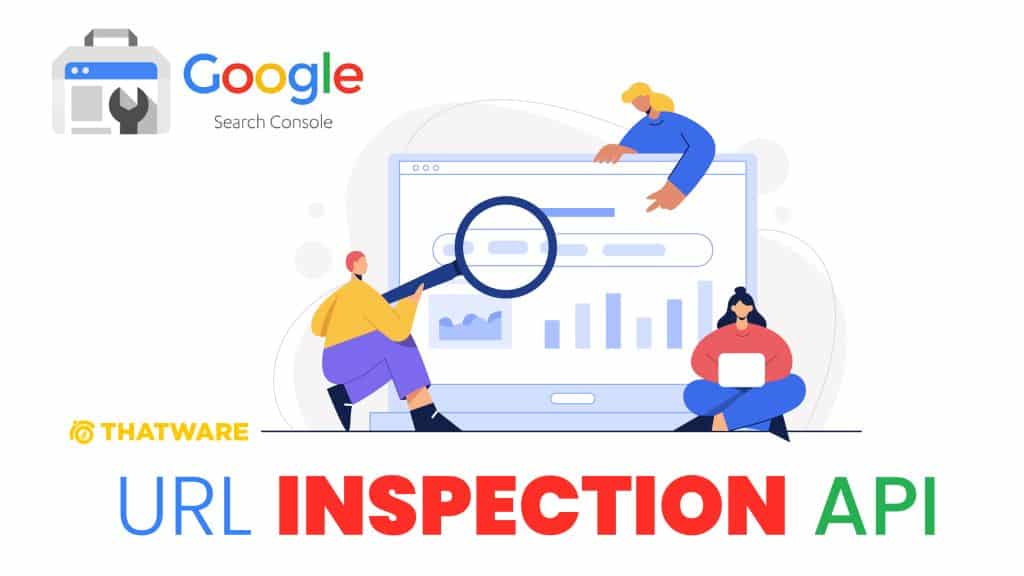
Usage Limits:
Here’s the integration procedure we have done for your campaign:
#Step 1
To connect, go to ‘Configuration > API Access > Google Search Console’, connect to your account, choose your property.
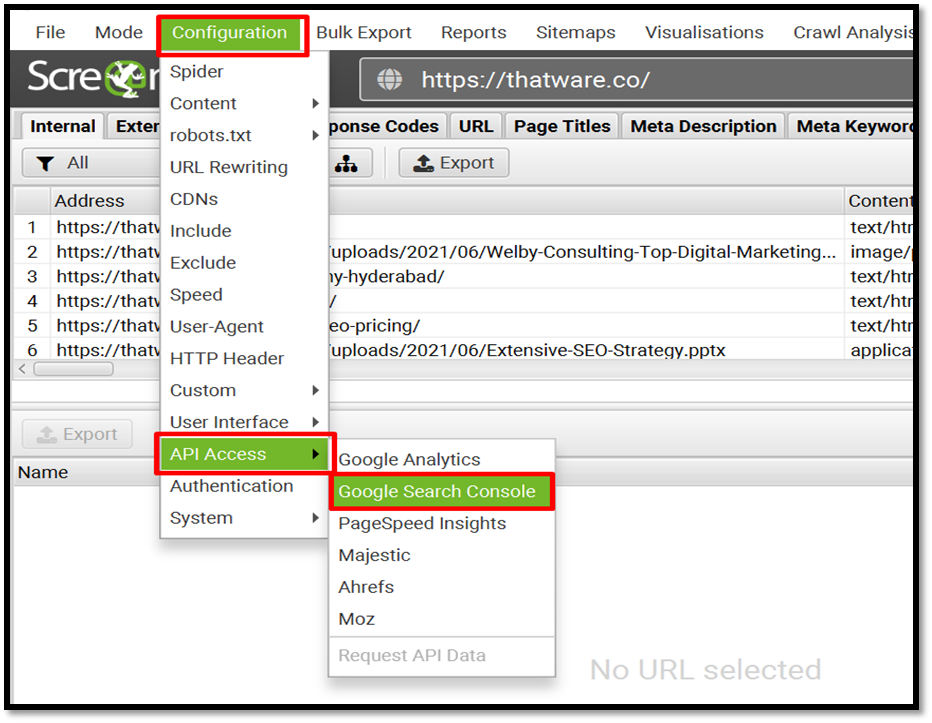
After that proceed to click ‘Connect to New Account’ as shown here:
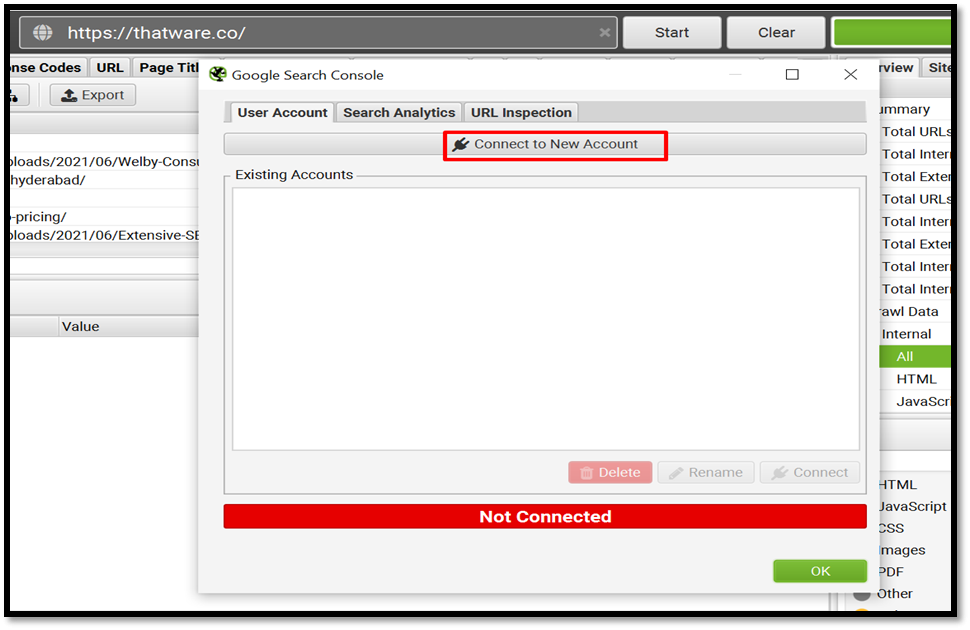
And then select the desired Google account to receive the verification code. A message will appear in the browser like this:

And you will need to select the desired property from the dropdown:
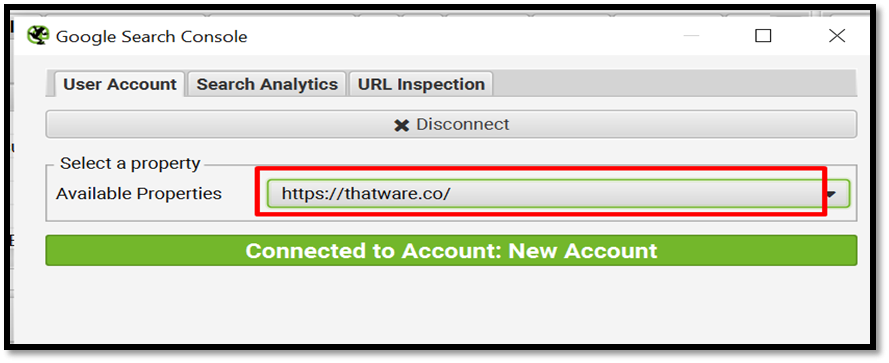
Next, tick the ‘Enable URL Inspection’ checkbox as stated below:
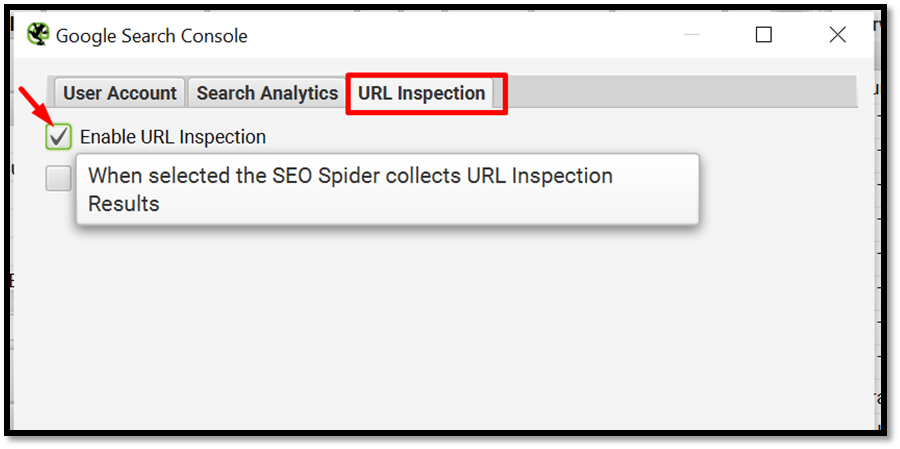
After integrating the Search Console API with Screaming Frog crawl the website:

#Here’s to the goal of new API filters:
URL Is Not on Google – The URL is not indexed by Google and won’t appear in the search results. This filter can include non-indexable URLs (such as those that are ‘noindex’) as well as Indexable URLs that are able to be indexed. It’s a catch-all filter for anything not on Google according to the API.
Indexable URL Not Indexed – Indexable URLs found in the crawl that are not indexed by Google and won’t appear in the search results. This can include URLs that unknown to Google, those that were discovered but not indexed, and more.
URL is on Google, But Has Issues – The URL is indexed and can appear in Google Search results, but there are some problems with mobile usability, AMP or Rich results that might mean it doesn’t appear in an optimal way.
User-Declared Canonical Not Selected – Google has chosen to index a different URL to the one declared by the user in the HTML. Canonicals are hints, and sometimes Google does a great job of this, other times it’s less than ideal.
Page Is Not Mobile Friendly – The page has issues on mobile devices.
AMP URL Is Invalid – The AMP has an error that prevents it from being indexed.
Rich Result Invalid – The URL has an error with one or more rich result enhancements that will prevent the rich result from showing in the Google search results.
Based on the above-mentioned filters here are the overall API data we get after full crawling:
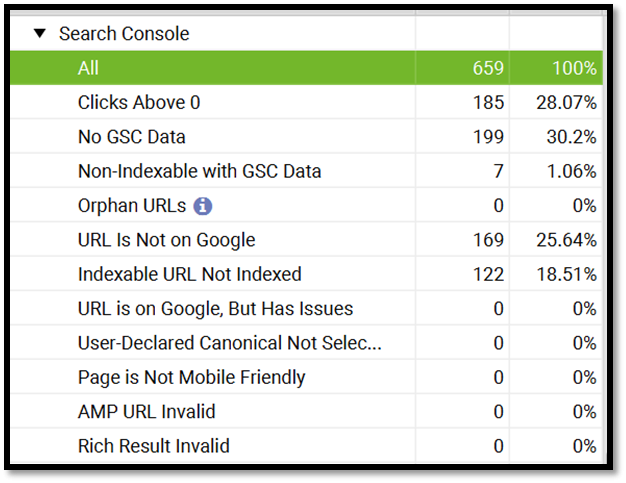
#Action plan moving forward with this GSC API data:
- You need to run the inspection through GSC. It is to fetch the Indexable URLs in Google for Indexable URL Not Indexed (122 URLs)
- You need to optimize the URLs from the list. And make it available to indexed in Google in terms of URL Is Not on Google (169 URLs)
Need for Integration Through Screaming Frog
Integrating tools and APIs into existing workflows is critical to simplifying processes, increasing efficiency, and overcoming digital marketing challenges, especially in SEO. Let’s look at the need to integrate the Google Search Console URL Validation API with the popular SEO tool Screaming Frog and the benefits it brings:
Manual URL Validation Challenges:
Manually validating URLs for SEO problems is a time-consuming and labor-intensive task. This includes navigating between different tools and platforms, copying and pasting URLs, and manually analyzing data. This process becomes increasingly cumbersome as websites grow in size and complexity. In addition, manual inspection can lead to human error, inconsistency in analysis, and delays in identifying and resolving problems.
Benefits of integrating the Google Search Console URL Validation API with Screaming Frog:
Automated Data Retrieval
By integrating the Google Search Console URL Validation API with Screaming Frog, users can automate URL validation by receiving critical information directly from the Google Search Console. This includes information about indexing status, indexing errors, and mobile accessibility issues. Automation reduces manual work and ensures that users have access to up-to-date information without manual intervention.
In-depth analysis
Combining Google Search Console data with Screaming Frog’s powerful indexing capabilities enables deeper SEO analysis. Users can identify a wider range of issues, such as pages with indexing issues, indexing errors, or mobile usability issues, and prioritize them based on how they affect search performance. This holistic approach enables more effective optimization strategies and better decisions.
Real-time insight
Integration with the Google Search Console API provides real-time insights into how Googlebot is interacting with your website. Users can quickly identify emerging issues, monitor index status changes, and monitor the impact of optimization actions over time. Real-time insights allow you to proactively manage SEO issues and help maintain healthy website visibility in search results.
Customization and flexibility
API integration with Screaming Frog provides customization options that allow users to tailor the analytics workflow to their needs. They can choose what data and data points to pull from the Google Search Console, customize reports, and automate tasks under predefined conditions. This flexibility allows users to create a workflow that matches their SEO goals and preferences.
Simplify your SEO analysis workflow
Google Search Console URL Inspection API integration with Screaming Frog simplifies your SEO analysis workflow by aggregating data, automating repetitive tasks, and providing actionable insights in one platform. This integration eliminates the need to switch between multiple tools and platforms, saving time and improving productivity. In addition, it facilitates collaboration between team members by providing a unified environment for SEO analysis and optimization.
Overall, integrating the Google Search Console URL Validation API with Screaming Frog solves the challenges of manual URL validation and offers many benefits to simplify SEO analysis workflows. By automating data, providing deep insight, and enabling personalization, this integration improves the efficiency, accuracy, and effectiveness of your SEO efforts.
Benefits of Integrating The Google Search Console URL Inspection API with Screaming Frog
Integrating the Google Search Console URL Inspection API with Screaming Frog offers significant advantages for SEO professionals and digital marketers. This powerful combination allows users to streamline processes, gain valuable insights, and optimize their website’s search performance. Below, we delve into each benefit in detail to highlight how this integration can revolutionize your SEO workflows.
1. Automated Data Retrieval
One of the standout benefits of integrating the Google Search Console URL Inspection API with Screaming Frog is the ability to automate data retrieval. Traditionally, checking a URL’s status and performance within Google Search Console involves manual effort, navigating between tools, and exporting data to analyze issues. With this integration, users can automate the process, pulling crucial information directly into Screaming Frog.
Key data points retrieved include:
- Indexing Status: Determine whether specific URLs are indexed by Google.
- Indexing Errors: Identify errors that prevent pages from being indexed correctly.
- Mobile Accessibility Issues: Uncover usability problems on mobile devices.
Automation significantly reduces manual workloads, ensuring that users always have access to the most current and accurate data without constant intervention. This is especially useful for large websites with thousands of URLs, where manual validation would be time-consuming and prone to errors. By automating these tasks, SEO teams can focus on more strategic activities, like addressing critical technical issues and implementing optimization strategies.
2. In-Depth Analysis
The integration enables users to combine the in-depth crawling capabilities of Screaming Frog with the live data provided by the Google Search Console API. This synergy offers unparalleled insights into a website’s technical health and search performance.
Using the combined data, users can:
- Identify Indexing Issues: Detect URLs that Google cannot crawl or index properly, helping to uncover technical barriers like incorrect canonical tags, blocked pages, or server errors.
- Pinpoint Mobile Usability Problems: Analyze pages flagged for poor mobile usability, such as content that overflows the screen or buttons that are too small to interact with easily.
- Address Duplicate Content: Find and resolve duplicate content issues that might confuse search engines and harm rankings.
The in-depth analysis allows SEO professionals to prioritize issues based on their impact on search performance. For instance, critical errors on high-traffic pages can be addressed first, while minor issues on less important pages can be scheduled for later. This holistic approach ensures that resources are allocated efficiently, resulting in more effective optimization strategies and better overall results.
3. Real-Time Insights
Real-time data is a game-changer in the world of SEO. The Google Search Console URL Inspection API integration with Screaming Frog provides live insights into how Googlebot interacts with your website. This immediate access to data allows users to monitor changes and respond proactively to emerging issues.
Real-time insights can be used to:
- Monitor Indexing Status: Track the status of specific URLs to ensure they are indexed promptly after publication or updates.
- Identify Emerging Issues: Quickly detect and resolve problems such as server errors, crawl budget wastage, or incorrect redirects.
- Measure Optimization Impact: Observe how recent SEO changes, such as improving page speed or fixing schema errors, affect Google’s perception of your site.
By staying updated with real-time data, SEO professionals can make informed decisions, avoiding costly delays that might harm a website’s search visibility. This level of immediacy is especially valuable for websites operating in competitive industries, where being proactive can make a significant difference.
4. Customization & Flexibility
Another major benefit of this integration is the customization and flexibility it offers. SEO teams have diverse needs, and the ability to tailor data retrieval and analysis workflows is crucial for maximizing efficiency.
With this integration, users can:
- Select Relevant Data Points: Choose specific metrics or data fields to extract from the Google Search Console, ensuring that reports focus on what matters most.
- Create Custom Reports: Generate tailored reports that align with specific business goals or client requirements.
- Automate Tasks: Set up automated tasks and triggers, such as running a weekly URL inspection for high-priority pages.
This level of customization allows users to adapt the workflow to their unique requirements. Whether you’re working on a small site or managing a large e-commerce platform with millions of pages, the integration can be configured to suit your needs. Flexibility ensures that your SEO efforts are not only effective but also aligned with your overall business objectives.
5. Simplified SEO Analysis Workflow
Managing SEO analysis can be overwhelming, especially when switching between multiple tools to gather and analyze data. The integration of the Google Search Console URL Inspection API with Screaming Frog simplifies this process by consolidating data and automating repetitive tasks.
Key benefits include:
- Centralized Data Analysis: Access all critical information within a single platform, eliminating the need to juggle multiple tools.
- Time Savings: Automate tasks like URL validation, crawling, and data retrieval, freeing up valuable time for strategic decision-making.
- Collaboration: Share insights and reports with team members more easily, fostering collaboration and alignment on SEO strategies.
This streamlined workflow not only saves time but also reduces the risk of errors caused by manual data handling. It enhances productivity and ensures that teams can focus on delivering impactful SEO optimizations rather than getting bogged down in administrative tasks.
6. Boosted Efficiency, Accuracy, and Effectiveness
The integration addresses many of the challenges associated with manual URL validation and data analysis. By automating data retrieval, providing deeper insights, and enabling workflow customization, it significantly boosts the efficiency, accuracy, and effectiveness of SEO efforts.
- Efficiency: Automating repetitive tasks allows SEO professionals to focus on strategy and execution.
- Accuracy: Real-time data from Google ensures that decisions are based on the latest and most reliable information.
- Effectiveness: Holistic insights and streamlined workflows result in more impactful optimizations and better search performance.
For businesses aiming to maintain a competitive edge in search engine results, these improvements can make a substantial difference. The integration empowers teams to work smarter, not harder, achieving better results with fewer resources.
Integrating the Google Search Console URL Inspection API with Screaming Frog is a must-have for modern SEO professionals. It automates data retrieval, facilitates in-depth analysis, and provides real-time insights that are critical for making informed decisions. The customization options and simplified workflow further enhance its value, allowing users to tailor the integration to their specific needs.
This powerful combination not only saves time and reduces manual effort but also improves the accuracy and effectiveness of SEO efforts. By adopting this integration, you can overcome the challenges of manual URL validation, streamline your SEO processes, and drive better results in search engine visibility and performance.
Whether you’re managing a small business website or a large enterprise platform, integrating the Google Search Console URL Inspection API with Screaming Frog is a step toward smarter, more efficient SEO management. Start leveraging this powerful toolset today and elevate your website’s performance in the ever-competitive digital landscape.
Prerequisite for Integration with Screaming Frog
Before integrating the Google Search Console URL Inspection API with Screaming Frog, there are several conditions you must meet. These include meeting the requirements for using the Google Search Console API, setting up a project on Google Cloud Platform (GCP), and creating API credentials.
Detailed Requirements for Using The Google Search Console API
The Google Search Console API is an invaluable resource for webmasters and SEO professionals looking to automate data retrieval and optimize their website’s performance in search results. However, to utilize this API effectively, you must meet certain prerequisites and follow specific setup steps. This guide elaborates on these requirements to help you navigate the process with ease.
1. Google Account
A Google Account is the foundational requirement for using the Google Search Console API. This account plays a critical role in both authentication and authorization when accessing API features.
- Purpose of a Google Account:
It serves as your unique identifier for accessing Google services like Google Search Console (GSC) and the Google Cloud Platform (GCP).
The account ensures secure API authentication, granting access only to verified users.
- Importance of Security:
Your Google Account must be secure, as it provides access to sensitive website performance data. Enabling two-factor authentication (2FA) adds an additional layer of protection.
- Ease of Access Across Services:
Once logged into your Google Account, you can seamlessly switch between GSC, GCP, and other tools necessary for API setup and usage.
- Actionable Tip:
Use a dedicated Google Account for your website projects to maintain better organization and avoid mixing personal data with professional tasks.
2. Website Verification in Google Search Console
To use the Google Search Console API, your website must first be verified in Google Search Console. Verification confirms ownership and unlocks access to detailed data and insights about your site’s performance in Google Search.
- Why Verification is Necessary:
It ensures that only authorized users can access website data, protecting sensitive information.
- Verification enables you to monitor and analyze key metrics such as indexing status, traffic, and search appearance.
- Methods of Verification: Google provides several options to verify ownership:
- HTML File Upload:
Download a verification file from GSC and upload it to your site’s root directory. - Meta Tag:
Add a specific meta tag to your site’s <head> section. - DNS Verification:
Add a TXT record to your domain’s DNS settings. - Google Analytics or Tag Manager:
Use existing accounts linked to your website for easy verification.
- HTML File Upload:
- Ongoing Maintenance:
- Once verified, periodically review your verification method, especially if you change hosting providers, update your DNS settings, or migrate your website.
Best Practice:
Keep your verification method simple and documented to ensure uninterrupted access, even during technical changes.
3. Creating A Search Console Feature for Your Website
In Google Search Console, you need to create a feature for your website. This feature acts as a centralized data container, storing metrics and reports related to your site’s search performance.
- Purpose of The Search Console Feature:
- It organizes and provides access to crucial performance metrics, including clicks, impressions, average ranking position, and click-through rate (CTR).
- It logs issues related to indexing, structured data, and mobile usability, ensuring you stay informed about your site’s health.
- Linking with the API:
- Properly setting up your website’s Search Console feature is essential for seamless API integration. Without this setup, the API cannot fetch data effectively.
Pro Tip:
When managing multiple properties (e.g., subdomains or separate websites), name each Search Console feature descriptively to avoid confusion.
4. Setting Up A Google Cloud Platform (GCP) Project
The Google Cloud Platform (GCP) serves as the backbone for managing API access. You must create a project in GCP to enable and configure the Google Search Console API. This project acts as a workspace for handling credentials, permissions, and API usage.
- Steps to Create a GCP Project:
- Log into GCP Console:
Visit the Google Cloud Console and sign in with your Google Account. - Create a New Project:
Click the “Create Project” button, provide a meaningful name (e.g., “My Website API Integration”), and assign a location. - Access the Project Dashboard:
The dashboard is where you’ll manage all aspects of API integration, from enabling services to setting up credentials.
- Log into GCP Console:
- Managing Roles and Permissions:
- Assign roles to collaborators, such as “Owner” for full control or “Editor” for partial access. This ensures secure collaboration.
Quick Tip:
Organize your GCP projects efficiently by labeling them according to specific clients or websites.
5. Enabling The Google Search Console API
Enabling the Google Search Console API is a critical step that allows your GCP project to interact with your website’s Search Console data. Here’s how to do it:
- Navigate to the API Library:
- In your GCP project, go to “APIs & Services” > “Library.”
- Search for the API:
- Use the search bar to locate the “Google Search Console API.”
- Enable the API:
- Click on the API and hit the “Enable” button. Once enabled, it will appear under the “Enabled APIs” section of your project.
- Monitor Usage:
- The API has usage limits (e.g., daily query quotas). Monitoring usage ensures you don’t exceed these limits and face interruptions.
Best Practice:
Familiarize yourself with the API’s quota policies and optimize your requests to stay within allowable limits.
6. Setting Up API Credentials
API credentials are essential for authenticating and authorizing requests made to the Google Search Console API. These credentials ensure that only your application can access your data.
- Types of Credentials:
- API Key:
Suitable for simple use cases but less secure for sensitive data. - OAuth 2.0 Client ID:
Recommended for most integrations, offering robust security and control.
- API Key:
- Steps to Create Credentials:
- In GCP, go to “APIs & Services” > “Credentials.”
- Click “Create Credentials” and select the appropriate option.
- Configure the OAuth consent screen, providing details such as your app name and privacy policy URL.
- Download the credentials file (JSON format) for use in applications like Screaming Frog or custom scripts.
- Security Measures:
- Store your credentials securely and avoid sharing them publicly.
- Rotate API keys regularly to enhance security.
Pro Tip:
Always use OAuth 2.0 credentials for production environments to ensure optimal security.
Meeting the requirements for using the Google Search Console API is a multi-step process that ensures secure and effective integration. From verifying your website in Google Search Console to creating a GCP project and enabling the API, each step plays a crucial role in setting up this powerful tool. By following these detailed guidelines, you can unlock valuable insights, automate tasks, and elevate your website’s performance in search engines.
Creating API Credentials (API Key and OAuth 2.0 Tokens)
API key
The API key is a unique identifier that allows applications to authenticate themselves when accessing the Google Search Console API. API keys are typically used for server-to-server communication and do not require user authentication.
OAuth 2.0 Credentials
OAuth 2.0 credentials are used to authenticate and authorize users. These consist of a client ID and client secret, which are used to obtain credentials that authorize the application to access the user’s Google Search Console data.
By fulfilling these prerequisites, users can access the Google Search Console API and obtain the necessary credentials to integrate it with SEO analysis and optimizations such as Screaming Frog.
Final Words
As technology advances and user needs change, it is very important to anticipate future developments and considerations for integrating the Google Search Console API with tools such as Screaming Frog. Here are some possible improvements and updates, as well as monitoring API policy and exploring additional integration options to consider:
Possible integration improvements and updates:
Improved data analysis
Future development may focus on improving data analytical skills. in Screaming Frog using the additional functions of the Google Search Console API. This can include deeper insights into search performance metrics, advanced data visualizations and integration with machine learning algorithms for predictive analytics.
Automation and Workflow Optimization
Screaming Frog’s SEO analytics workflows can be further automated by adding advanced scripts and customization options. This can simplify repetitive tasks, improve efficiency, and allow users to focus on strategic decisions instead of manual data processing.
Integration with other tools and platforms
Future updates may include the integration of Screaming Frog with other SEO tools and platforms to provide a more holistic approach to website optimization. This can include seamless exchange of data between different tools, centralized reporting dashboards, and collaboration capabilities for cross-functional teams.

Thatware | Founder & CEO
Tuhin is recognized across the globe for his vision to revolutionize digital transformation industry with the help of cutting-edge technology. He won bronze for India at the Stevie Awards USA as well as winning the India Business Awards, India Technology Award, Top 100 influential tech leaders from Analytics Insights, Clutch Global Front runner in digital marketing, founder of the fastest growing company in Asia by The CEO Magazine and is a TEDx speaker and BrightonSEO speaker.


